

Table of contents
- Aloe from A to F
- Aloe from G to P
- Aloe from S to V
Aloe captivate with impressive leaf rosettes and attractive flowers if they are well cared for. There are over 440 varieties, of which only the most important are briefly presented here. These include specimens with or without a stem, edible and poisonous varieties and the well-known aloe vera. It should be noted that there are almost no hardy aloe varieties, they all have to be overwintered frost-free.
Aloe from A to F
Aloe aculeata
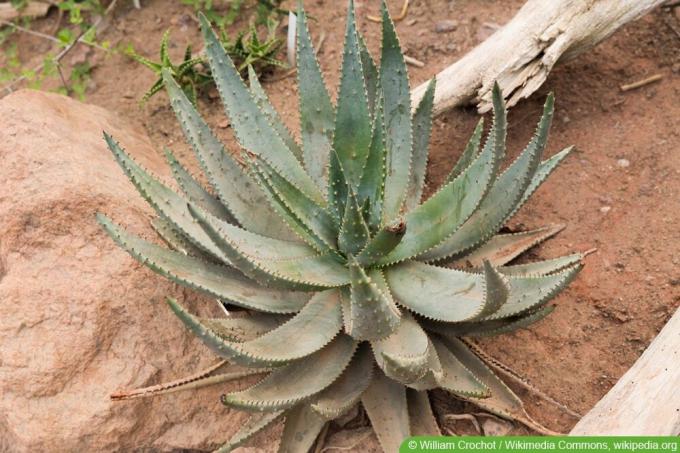
This variety is one of the stemless variants and shines with a large leaf rosette with thick leaves, which are covered with defensive thorns, which is typical for aloe species. The leaves are up to 60 cm long and 12 cm wide.
- possibly a creeping stem
- Inflorescence reaches 1 m in height
- Flower color lemon yellow
Aloe africana
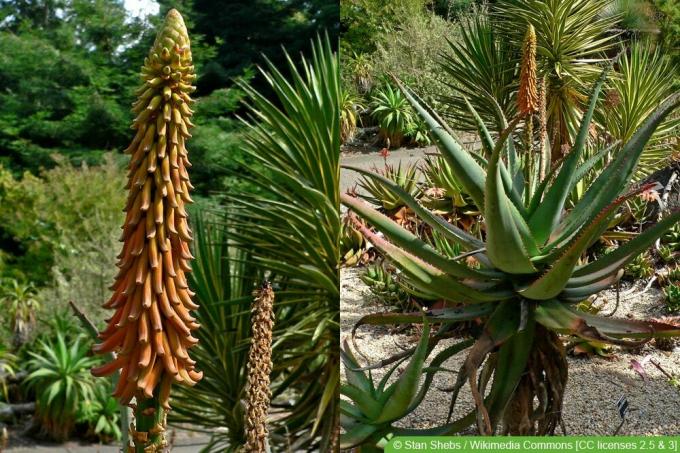
Stan Shebs, Aloe africana 1, edited by Hausgarten, CC BY-SA 3.0.
As its name indicates, the variety comes from Africa. The rosette of leaves sits on a stem. The individual leaves are up to 30 cm long. The flowers appear as candle-like, densely occupied inflorescences.
- Trunk height up to 4 m
- Inflorescence 60 to 80 cm
- branched growth
- Flower color yellow to yellow-orange
Aloe arborescents

This variety belongs to the tree aloes and grows several meters high. Its special feature lies in its healing effect, which is even scientifically proven because it is approved as a medicinal plant. So this aloe is edible. In contrast to other aloes, it can withstand a few minus degrees without being endangered.
Tip:
Edible does not mean that all parts of the plant are edible.
- Trunk height up to 3 m
- Inflorescence 60 to 80 cm high
- Flowers are scarlet
Aloe bainesii or Aloe barberae

This variety is also a tree aloe that grows between 18 and 20 m high in its homeland. However, it grows very slowly. The trunk diameter can reach 1 to 3 m.
- Variety is from South Africa
- Inflorescence 40 to 60 cm long
- Flower color pink to rose-purple
Aloe broomii
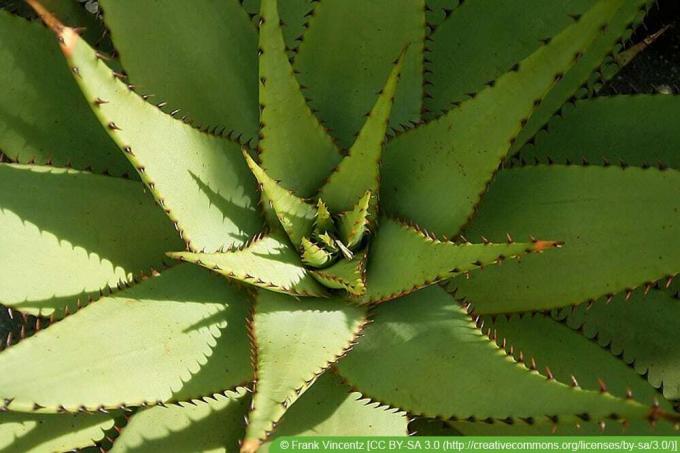
This aloe is also native to South Africa. It forms a short trunk, the leaves are up to 30 cm long and 10 cm wide at the base.
- Trunk height up to 1 m
- Inflorescence is 1.50 m long
- Flower color white or lemon yellow with a brown tip
Aloe chabaudii

The leaves of this variety are reddish-green in color at the edges, which gives it a very attractive appearance. This aloe belongs to the undemanding varieties, its homeland is in Africa, where it is found at an altitude of up to 1600 meters. The species likes to form small groups.
- Inflorescence 60 to 80 cm long
- grows branched
- Flower color brick red
Aloe claviflora

As with the other varieties, the leaves of this aloe are provided with small thorns. The species has no stem, the leaves are about 20 cm long. The inflorescence grows longer and can reach 50 cm.
- Flower color red with a green tip
- yellowing after pollination
Aloe cryptopoda
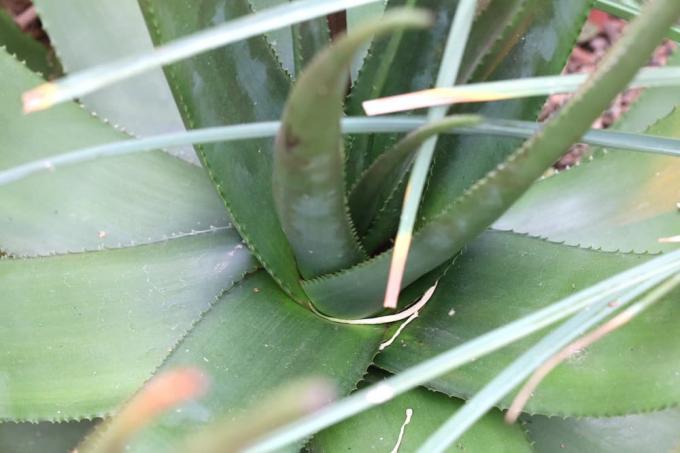
The plant grows solitary and without a stem. Sometimes, however, it sprouts and then grows in groups. The leaves are erect and pointed. They grow between 60 and 90 cm long.
- Inflorescence up to 175 cm long
- grows branched
- Flower color orange-scarlet and pointed yellowish
Aloe dichotoma - the quiver tree

As the German name shows, the variety belongs to the tree aloes. The crown forms a shape reminiscent of a quiver, hence the second part of the name. The blue-green leaves are about 35 cm long.
- another synonym: Kokerboom
- Inflorescence up to 30 cm long
- grows branched
- Flower color canary yellow
Aloe ferox – Cape Aloe
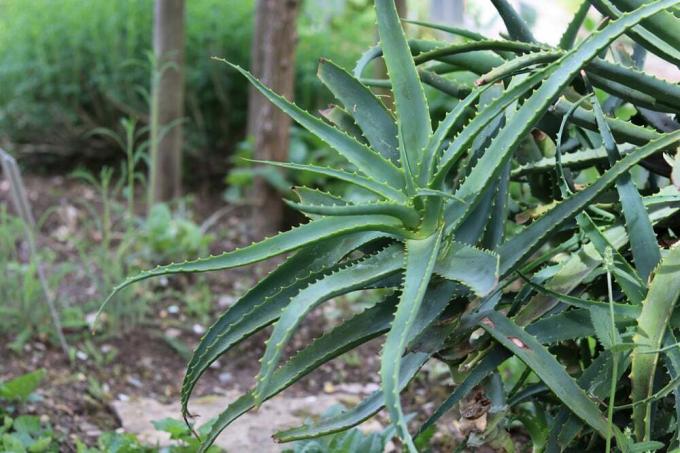
This variety also belongs to the tree aloes, whereby it only forms a short trunk that at most reaches 3 to 5 m in height. Sometimes the trunk is covered with dead leaves. The reddish leaves are particularly long, reaching up to 100 cm in length. This aloe is also one of the edible varieties. The thickened sap of the plant is used as a medicine.
- Inflorescence is branched
- Flower color scarlet or orange
Aloe from G to P
Aloe grandidentata

What is interesting about this aloe are the large "teeth" on the leaves and the piebald leaf pattern. It likes to grow in groups and does not form trunks.
- Origin Botswana or South Africa
- Inflorescence about 90 cm long
- grows branched
- Flower color reddish, sometimes white
Aloe greenii

The leaves of this aloe grow up to 45 cm long, making it one of the larger varieties. The white speckles and yellow-orange teeth on the leaves are interesting.
- comes from South Africa
- Inflorescence 130 cm long
- Flower color light to dark pink
Aloe koenenii
When young, this aloe is mottled white, later the leaves are only green in color. Compared to other species, it has very slender, upright leaves. Although it forms a trunk, this grows prostrate.
- comes from North Africa
- Inflorescence up to 120 cm long
- grows branched
- flowers carmine
Aloe lineata
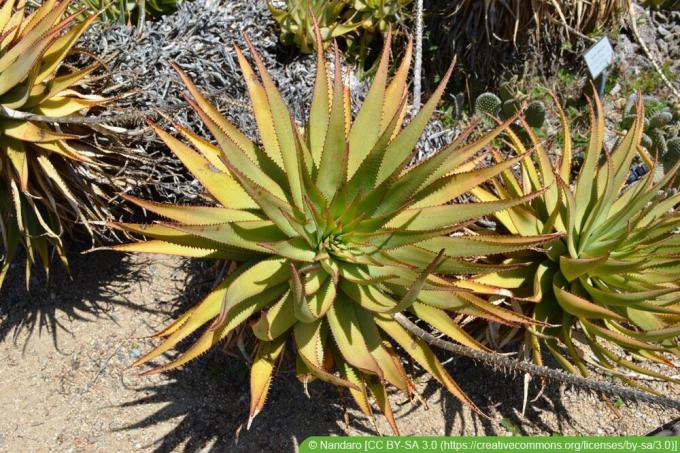
It initially grows close to the ground and forms a trunk as it ages. The leaves are comparatively thin and long.
- Trunk height up to 2 m
- Homeland South Africa
- Inflorescence 75 to 100 cm long
- Flower color salmon pink
Aloe lutescens

This aloe belongs to the stem-forming varieties and grows to a height of around 80 cm. The inflorescence towers over the plant by another 150 cm, making it particularly impressive. The flowering time is in winter.
- make groups
- Inflorescence tripartite
- Flower color yellow to reddish
Aloe macrocarpa
The name of this species means large fruit and indicates the fruiting of the aloe. The leaves grow to 30 cm long and are green with white speckles. The plant remains stemless or forms only a short stem.
- Inflorescence 80 to 100 cm
- grows branched
- flowers scarlet
Aloe mitriformis

This aloe belongs to the rather smaller species. The leaves are only 20 cm long, the rosette remains rather small. Although the trunk can reach a length of 2 m, it only grows lying down.
- Inflorescence 60 cm long
- Flower color scarlet
- distinct spines on the leaves
Aloe peglerae

The leaves of this aloe are blue-green and have the typical teeth that are supposed to ward off predators. In its country of origin, the plant occurs at altitudes of up to 1700 m. It grows there individually or in small groups and does not form a trunk or only a low-lying, short one. The shape of the leaves is interesting. They grow inward, giving the plant an almost spherical appearance.
- Inflorescence 40 cm
- Flower color creamy white to reddish
- belongs to the endangered species
Aloe percassa
The species grows compactly with thick, fleshy leaves. It is also on the Red List as its wild population is steadily declining. It forms no tribe or a prostrate tribe.
- Native to Ethiopia, Eritrea
- Inflorescence branched
- Height 60 to 80 cm
- Flower color scarlet
Aloe plicatilis
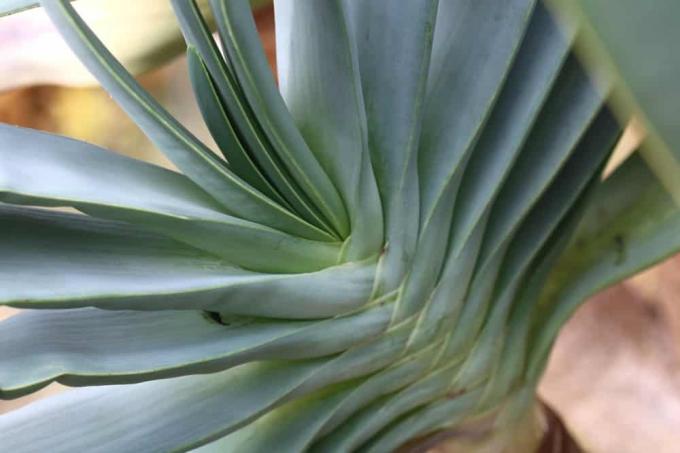
Unlike most other aloe species, the leaves of this species are not as defensive. The teeth are rather small and hardly visible. In addition, the leaves are not as thick as those of other aloes. The trunk can reach a height of up to 5 m and forms a branched crown.
- Inflorescence 50 cm high
- Flower color scarlet
Aloe polyphylla – spiral aloe
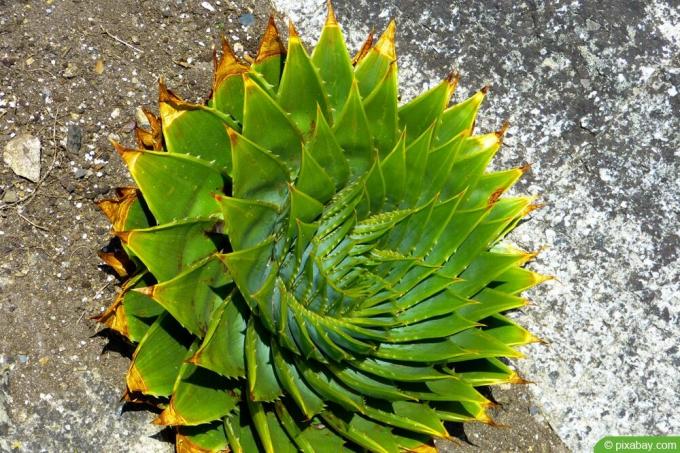
This species is one of the few that can survive a few sub-zero temperatures. In its homeland, it grows at altitudes of up to 2500 m. Another special feature is the leaf spiral that forms with age, which gives it an interesting appearance.
- stemless
- thick, branched inflorescence
- 50 to 60 cm high
- Flower color light red to salmon pink
Aloe pruinosa
The leaves of this aloe show a particularly strong and attractive pattern. Lighter, irregular bands stand out on a green background. The slender leaves are up to 50 cm long. The trunk can also be 50 cm long, but is not particularly noticeable because of its creeping growth.
- Inflorescence up to 2 m long
- grows branched
- Flower color brownish-red to pinkish-white
Aloe from S to V
Aloe saponaria or maculata - soap aloe
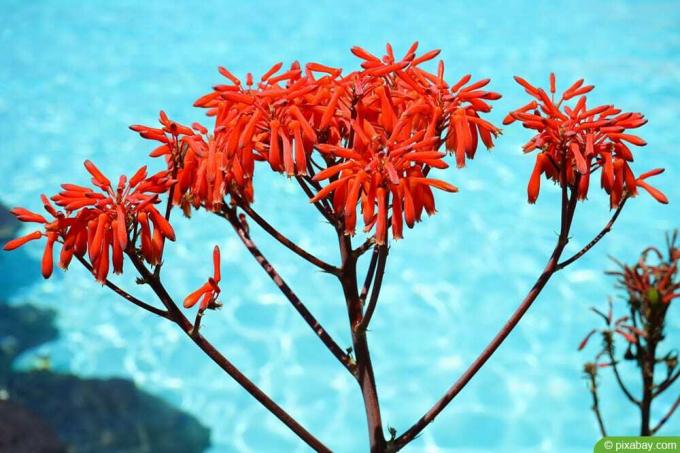
Both hands and laundry can be washed with the gel of this plant. It is used in cosmetic products. The aloe grows individually or in dense groups and does not form a trunk.
- Inflorescence 40 to 100 cm
- Flower color salmon pink, orange, yellow or red
Aloe somaliensis
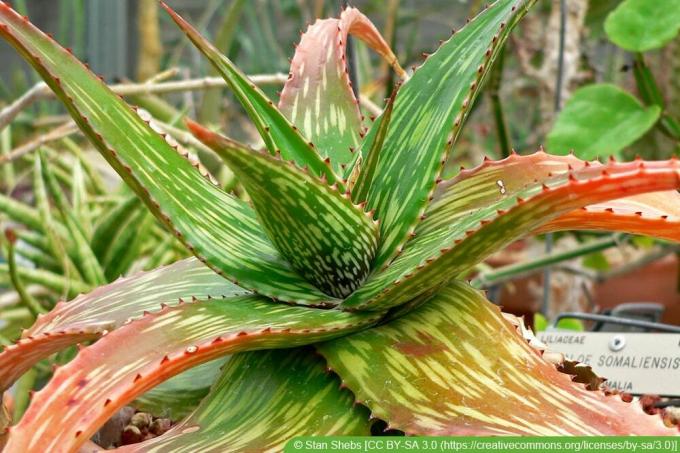
This aloe has almost no thorns and looks very pretty with its dense leaf pattern. It is originally from Somalia, where it grows without a stem and forms small groups. It is also one of the endangered species.
- Inflorescence 60 to 80 cm long
- branched
- pink or scarlet flowers with white speckles
Aloe spinosissima
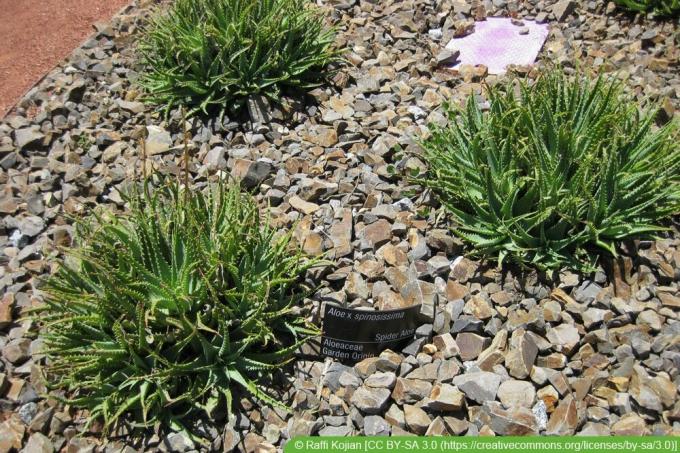
Sometimes referred to as spider aloe, it is a cultivated form of aloe. The leaves are long and thin. Growth takes place in dense, small clusters. It is therefore used as a ground cover in warm regions.
Aloe striatula
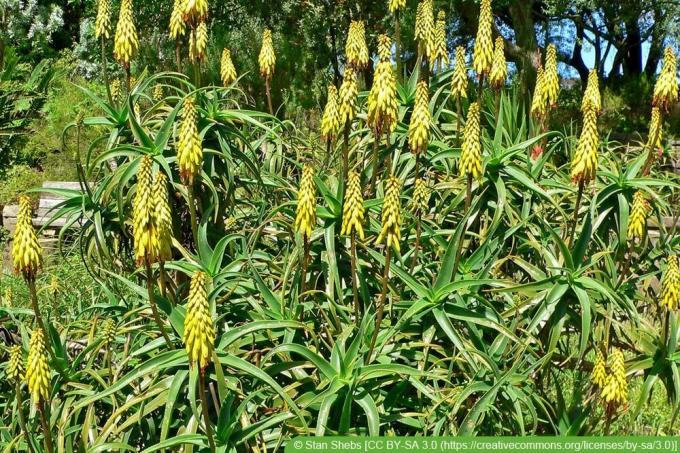
With a trunk of 175 cm in length, it clearly belongs to the tree aloes, even if it remains comparatively small. The leaves are about 60 cm long and have a white stripe that gave the species its name.
- Inflorescence 40 cm long
- Flower color orange to reddish
Aloe suprafoliata

It shows an interesting growth when young, which also gave this aloe its name. The pages are stacked open from the center like the pages in a book.
- stemless
- Inflorescence up to 100 cm
- Flowers pink to scarlet and frosted
Aloe vanbalenii
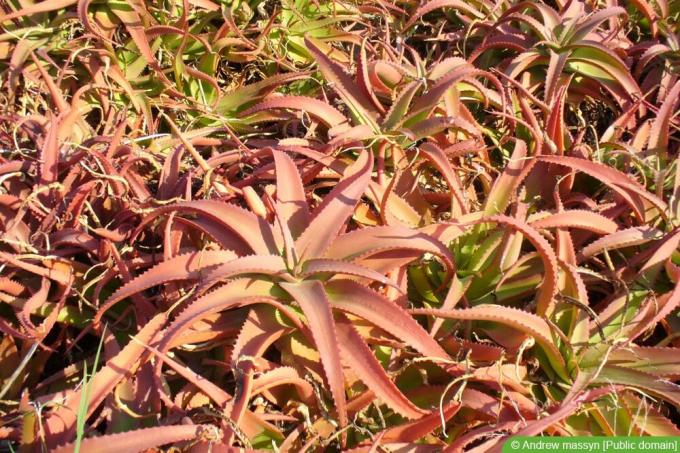
It is bright green when young, later changing to red-green. Its homeland is in South Africa, where it grows widely.
- stemless
- Inflorescence branched
- 100cm high
- Flower color rusty yellow or dull red
aloe vera
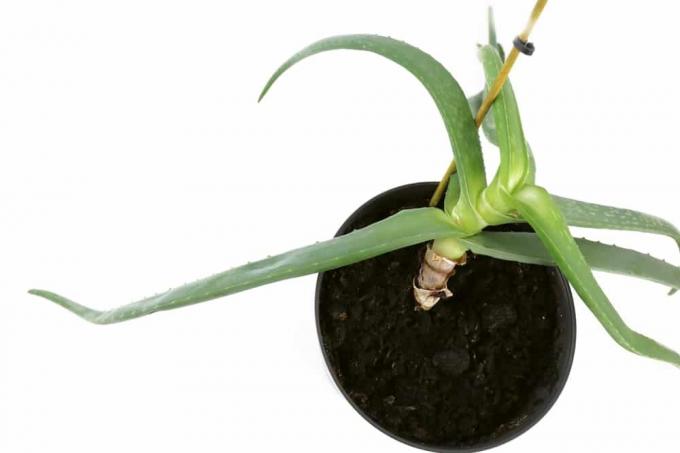
This is the most famous representative of the aloes. Which is not least due to the fact that it is said to have a far-reaching healing effect. Parts of the plant are edible, especially the gel inside the leaf. However, there are a few things to consider when preparing it, otherwise poisoning can occur.
A notice:
Using ready-made aloe vera products is safer than trying to get to the gel inside the leaves yourself.
- short stem or stemless
- Leaves 50 cm long
- Flower color orange
- Origin Arabian Peninsula
 Home editorial office
Home editorial office
Learn more about succulents

Aloe vera flowers: photo | use of the flowers
The aloe vera is a decorative, frugal and practical plant for the balcony and the house. But not only their leaves can be used, the unusual flowers also offer advantages and can be used in many ways.

Flowering cacti: 10 popular species from A-Z | 5 without sting
Cacti are often understood to be spiky, flowerless monsters that come from the desert and therefore need no care. Cast from time to time, they do not shrink, but they are not an ornament either. Not even close! Many varieties have beautiful flowers.

Triangular spurge: care and pruning of the cactus
The Triangular Spurge is a succulent plant that is ideal for indoor cultivation. In appearance, this exotic resembles cacti, as well as in care. Due to the poisonous plant sap, special protective measures are required when cutting to avoid symptoms of poisoning.

Rhipsalis cassutha: is it poisonous? Instructions for care and propagation
Also known as the coral or rod cactus, the Rhipsalis cassutha is an extravagant, robust and easy-care houseplant. The special thing about this cactus is its filigree, hanging and strongly branched shoots. The many small white flowers are also pretty to look at.
Queen of the Night Cactus - Caring for Selenicereus grandiflorus
The Queen of the Night does not bear her name wrongly, because the fascinating blooming splendor of older plants is a special feature. If you want to experience the flowering, which only lasts a few hours, you can cultivate Selenicereus grandiflorus in your own home without much effort. Read more about the care needs of the plant.
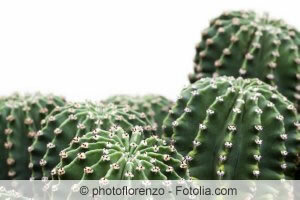
Echinopsis Cacti - Species/Variety and Care Tips
Many a passion for collecting began with a cactus of the genus Echinopsis. The cacti, which are spherical at first but become columnar when they are older, enchant with their wonderful blossoms and beguiling scent. Immerse yourself in the multifaceted world of Echinopsis cacti and get to know the most beautiful types and varieties, including useful care tips.
